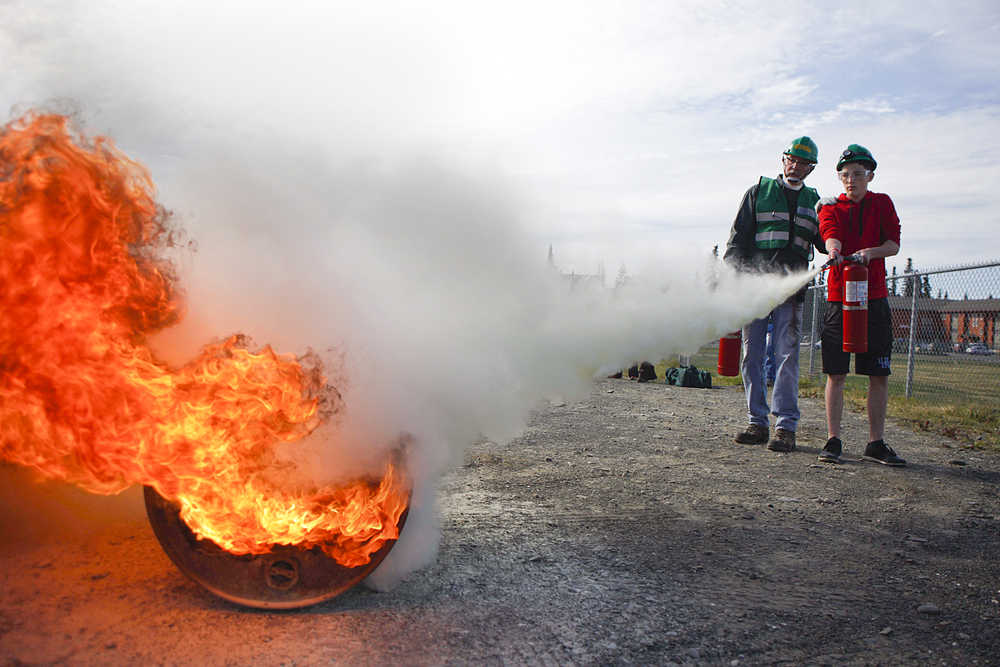Blackouts, radio dead zones, fire and runaway victims were all complications members of the latest Kenai Peninsula Community Emergency Response Team had to deal with during Saturday’s earthquake disaster simulation which completed their training in the program.
CERT, a national training program that came to the peninsula in 2005, prepares community members to respond to natural disasters and gives them skills and knowledge to help others, both personally and as volunteers.
During the exercise, CERT classmates split into different search groups and kept in touch via radios as they moved through the darkened halls of Soldotna Prep School — that is, until they hit the dead zone planned by KPB Office of Emergency Management Program Coordinator Dan Nelson. Other complications included victims who periodically wandered back into the building and an “aftershock” from the simulated earthquake that rocked a dumpster as participants tried to recover a victim from underneath it.
Instructor Michael Huckabay, who created the “aftershock” by shaking the dumpster, is a retired member of Central Emergency Services. He said the CERT course covers a broad range of skills, including search and rescue, medical response and first aid, fire response and team organization.
“One of the things that we run into of course is we have students who have different experiences,” Huckabay said.
Participants in this summer’s CERT class ranged in both age and level of previous experience with disasters.
Charles See, of Kenai, is 70 years old. He was assigned to the search team that checked the entire perimeter of the school before going inside.
“All of us want to help out in case there’s an emergency,” See said. “We’re not medical people necessarily or fire, but they get overwhelmed sometimes especially in a disaster, and the idea is for us to be there to help.”
In a previous interview with the Clarion, Dan Nelson, program coordinator for the Kenai Peninsula Borough Office of Emergency Management, said about 15 CERT volunteers were utilized during emergency response to the Card Street fire this summer. About 500 community members have been CERT certified peninsula-wide.
For Nelson, biggest challenge of putting on the more than 30-hour program is finding volunteers to help teach course material and participate in the disaster exercise, the final hurdle that puts what participants learn to the test.
“Most of our volunteers today are Boy Scouts and Girl Scouts,” Nelson said. “That volunteer commitment of 30 hours is a lot to ask.”
When there are fewer volunteers to play victims placed throughout the school, Nelson said he likes to add other complications to the simulation for participants. The skills they learn throughout the course and put to practice during the fake disaster are both valuable and long-lasting, he said.
“(The skills) will go with folks,” Nelson said. “That’s why young people can take it, older (people), it doesn’t matter. It’ll stay with them forever.”
With only nine community members involved in Saturday’s simulation, Nelson said this class was smaller than usual. The course was fitting, however, due to the recent Card Street fire and two earthquakes felt on the peninsula this summer.
Once certified, CERT members can choose to sign up to be called upon by emergency responders during a real disaster. Many, however, become certified simply to have a better understanding of how to react to a disaster and protect family and friends in the process. Several of Saturday’s classmates have been volunteering in their communities already, and saw CERT as a way to give back even more.
“I always like doing anything I can to help the community,” said Leah Vik, a participant from Anchorage. “I had a little bit of training before in emergency response. I’ve never been afraid to go into a situation.”
Daughn Carpenter, of Soldotna, has been volunteering in the town for years and was excited to finally get involved with CERT.
“I’ve always wanted to do this, but I never had anyone to do it with,” Carpenter said. “I really enjoyed it. I had a blast.”
Both women said the added stress of finding disappearing victims made the simulation harder, but they relied on the search plan that had been established by their classmate playing the part of incident commander. For Carpenter, extracting a victim from under a dumpster was most challenging.
Emergency response training for community members is especially important in Alaska, Vik said, because of the state’s relative isolation from the rest of the country.
“If any natural disaster were to happen here, we are almost completely cut off,” Vik said. If anything were to compromise the peninsula’s airport runways or road system, it could take a long time to get resources to the area.
Following the earthquake exercise, the CERT class was presented with certificates and their own bag of emergency response supplies. Nelson said classes from around the peninsula will be called together for supplemental training sessions starting this fall.
Reach Megan Pacer at megan.pacer@peninsulaclarion.com

